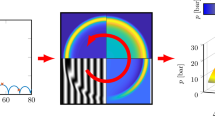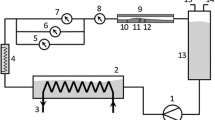Abstract
Cavitation plays an important role in fuel atomization mechanisms, but the physics of cavitation and its impact on spray formation and injector efficiency are not well documented yet. Experimental investigations are required to support the development and the validation of numerical models and the design of tomorrow’s injectors, in the context of pollutant and fuel consumption reduction. The complexity of modern injectors and the extreme conditions of injection do not facilitate experimental investigations. In this paper, experiments are conducted in a simplified geometry. The model nozzle consists of a transparent 2D micro-channel supplied with a test oil (ISO 4113). Three different optical techniques are proposed to investigate the channel flow, with the pressure drop between upstream and downstream chambers as a parameter. A shadowgraph-like imaging technique allows the observation of cavitation inception and vapor cavities development throughout the channel. The technique also reveals the presence of density gradients (pressure or temperature) in the channel flow. However, this additional information is balanced by difficulties in image interpretation, which are discussed in the paper. In addition, a combination of Schlieren technique and interferometric imaging is used to measure the density fields inside the channel. The three techniques results are carefully analyzed and confronted. These results reveal a wealth of information on the flow, with pressure waves generated by bubble collapses, turbulence in the wake of vapor cavities and bubble survival in flow regions of high pressure. Our results also show that cavitation inception is located in the shear layers between the recirculation zones and the main flow, relatively far from the inlet corner, where the pressure is minimum in average. To explain this behavior, we propose a scenario of cavitation inception based on the occurrence and the growing of instabilities in the shear layers.






















Similar content being viewed by others
References
Badock C, Wirth R, Fath A, Leipertz A (1999) Investigation of cavitation in real size diesel injection nozzles. Int J Heat Fluid Flow 20:538–544
Bergwerk W (1959) Flow pattern in diesel nozzle spray holes. Proc Inst Mech Eng 173:655–660
Chang JC, Huang SB, Lin CM (2006) Effect of inlet surface roughness, texture, and nozzle material on cavitation. Atomization Sprays 16:299–317
Jung D, Wang WL, Knafl A, Jacobs TJ, Hu SJ, Assanis DN (2008) Experimental investigation of abrasive flow machining effects on injector nozzle geometries, engine performance, and emissions in a DI diesel engine. Int J Automot Technol 9:9–15
Merzkirch W (1974) Flow visualization. Academic Press, New York
Morini GL (2005) Viscous heating in liquid flows in micro-channels. Int J Heat Mass Transf 48:3637–3647
Ndiaye EHI, Bazile JP, Nasri D, Boned C, Daridon JL (2011) Private communication. Laboratoire des Fluides Complexes et leurs Réservoirs, UMR CNRS 5150, Université de Pau
Nurick WH (1976) Orifice cavitation and its effects on spray mixing. J Fluids Eng 98:681–687
Payri R, Garcia JM, Salvador FJ, Gimeno J (2005) Using spray momentum flux measurements to understand the influence of diesel nozzle geometry on spray characteristics. Fuel 84:551–561
Rayleigh L (1917) VIII. On the pressure developed in a liquid during the collapse of a spherical cavity. Philosophical Magazine Series 6, 34:200, 94–98
Roosen P (2007) Investigation of the transient behaviour of cavitation effects in liquid injection nozzles. In: Transient phenomena in multiphase and multicomponent systems. Wiley-VCH Verlag GmbH & Co. KGaA, pp 72–83
Schmidt DP, Rutland CJ, Corradini ML (1997) A numerical study of cavitating flow through various nozzle shapes. SAE Trans J Eng 106:1644–1673
Sezal IH, Schmidt SJ, Schnerr GH, Thalhamer M, Förster M (2009) Shock and wave dynamics in cavitating compressible liquid flows in injection nozzles. Shock Waves 19:49–58
Soteriou C, Andrews R, Smith M (1995) Direct injection diesel sprays and the effect of cavitation and hydraulic flip on atomization. SAE technical paper 950080. doi:10.4271/950080
Winklhofer E, Kull E, Kelz E, Morozov A (2001) Comprehensive hydraulic and flow field documentation in model throttle experiments under cavitation conditions. ILASS-Europe, 2–6 Sept 2001, Zurich Switzerland. http://www.ilasseurope.org/ICLASS/ilass2001/ILASS2001.pdf
Winklhofer E, Kelz E, Morozov A (2003) Basic flow processes in high pressure fuel injection equipment. ICLASS, 13–17 July 2003, Sorrento, Italy. http://www.ilasseurope.org/ICLASS/iclass2003/fullpapers/1409.pdf
Acknowledgments
This work takes place in the French collaborative program NADIA-bio (New Advance Diesel Injection Diagnosis for bio fuels). This program is supported by the French Automotive Cluster Mov’eo and funded by the DGCIS (Direction Générale de la Compétitivité, de l’Industrie et des Services), the Région Haute Normandie and the Conseil Général des Yvelines.
Author information
Authors and Affiliations
Corresponding author
Rights and permissions
About this article
Cite this article
Mauger, C., Méès, L., Michard, M. et al. Shadowgraph, Schlieren and interferometry in a 2D cavitating channel flow. Exp Fluids 53, 1895–1913 (2012). https://doi.org/10.1007/s00348-012-1404-3
Received:
Revised:
Accepted:
Published:
Issue Date:
DOI: https://doi.org/10.1007/s00348-012-1404-3




